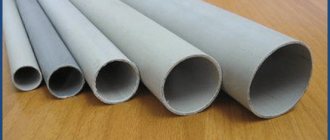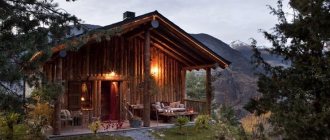Most dachas in Russia are rarely used in winter, since they were originally built for summer holidays and, due to their characteristics (wall materials, insulation), are unsuitable for living at sub-zero temperatures. At this time, most summer residents move back to the city, leaving their country houses without light and heating.
However, before leaving an unheated dacha face to face with frost, it is necessary to carry out a number of preparatory measures, because the water in the pipeline can simply freeze. If you do not prepare the water supply system for frost, then in the spring you may be in for a surprise, because frozen water during a new start-up can severely damage the pipeline.
That is why it is so important to remove all water from the pipeline, irrigation systems, pumps, etc. before winter at the dacha. In this article we will tell you in detail about how to properly preserve the water supply in the country.
Why blow out water pipes before frost?
The main problem of all country water pipes is freezing of water at subzero temperatures. Such a decrease in temperature negatively affects not only the pipeline, but also other equipment. An air compressor can help avoid such consequences; it can be used to clear water from the pipeline so that it does not freeze in it in winter.
This process removes water from:
- Water pipelines unprotected from frost (usually they run between nearby buildings);
- Automatic watering systems;
- Drinkers for animals operating in automatic mode;
- Structures for supplying water to swimming pools.
During the purging process, you need to understand that a pressure of more than 10 atmospheres cannot be supplied to the country pipeline. Otherwise, the pipeline may rupture or leaks will appear over time.
Areas of application for purging
It is important to know the applications of the compressor in which the blower is a necessary equipment.
More than one water supply needs preparation for the winter period, the cleaning process of which is a common activity, especially for its internal part.
The temperature in the room is always higher than in the outside space, which means that the occurrence of negative temperatures inside the house is a very rare phenomenon.
The most common cases of damage include problems in the following systems:
- in external automatic watering;
- in a pipeline located inside rooms that are not heated;
- in the external (street) water supply;
- in pet feeders;
- in the water supply connected to the pool;
- pumps and pumps
The systems listed above also require pre-purge using a compressor.
Preparing the country water supply for winter
The process of preparing a pipeline at the dacha itself is simple. However, it is important to do all the steps in a certain order, otherwise you may make mistakes and not drain all the remaining water.
First of all, prepare buckets and other containers before starting work. Blowing with a compressor is carried out as follows:
- Turn off the water completely and then drain the system. At this stage, some of the water will flow out of the pipes by gravity, and the rest will have to be blown out;
- Disconnect other pipeline branches from the central one, so you can isolate them for further purging. Don't forget to install plugs, otherwise a lot of water will spill out;
- Connect the inlet pipe to part of the pipeline, and then plug in the air compressor. When the water stops flowing, the water cleaning is complete and you can turn off the air blower;
- Additionally, the pipes should be mechanically cleaned to remove accumulated deposits (usually minerals and salts).
It is better to carry out the preparatory work on purging the pipeline with a partner, so you can do it faster.
Step-by-step purging process
You should pay attention to the purging of the pipeline as a whole. Starting the process will require a stationary or mobile compressor, as well as access to the drain valve, pipe distribution points and all inlets.
As auxiliary equipment, you can use buckets, various containers, as well as wire for cleaning pipes.
The blowing technology is as follows:
- It is necessary to turn off the water supply. In the situation of connecting to the central system, they try to block it completely.
- The remaining water is drained independently.
- Remove plugs and plumbing fixtures and insulate other areas.
- Turn off all heating equipment, including the boiler. All such structures are isolated from the pipeline.
- Remove foreign devices from pipes if they are clogged.
- The pipeline is connected to any inlet pipe of the compressor. It would be a good idea to take care of this during the construction process by designing a separate branch with lockable fittings.
- Turn on the compressor.
- Monitor outlets from the water supply system. The cessation of water release and the start of air release serves as a signal to turn off.
It would be useful to have the help of a helper who will monitor the progress of the purge. It is advisable to inspect pipes in several sections simultaneously so as not to load the pipeline several times. Since winterizing the system is quite complex, many jobs may require an extra pair of hands.
It should be noted that the proposed method can blow out the entire pipeline at one time. However, this is not without danger. The best option would still be stage-by-stage blowing, carried out in separate areas. Of course, this will affect the duration of its implementation, but will ensure a reliable result at the end.
What equipment is needed to blow out pipes?
Plumbing compressors come in a variety of varieties, and their use is not limited to purging pipelines. Below we will tell you in detail about existing compressors, and then you can make the right choice.
Scroll compressors
These devices are primarily characterized by their high reliability and long service life. They are so called because the main element of the installation is a special spiral, which is perfectly balanced, so vibrations are practically not felt during operation.
There are few moving elements in the installation of a scroll compressor, so no extraneous pulsations are observed when the pressure increases. This compressor differs from the piston compressor in its increased volume.
Diaphragm compressors
In such devices, air compression occurs under the influence of a membrane. In this installation, it performs a reciprocating motion, and thus performs the same functions as a piston.
Diaphragm compressors differ:
- stable long-term work;
- long service life;
- ease of use;
- corrosion resistance;
- safety to use.
Inside such a compressor there is a dense rubber chamber; it plays the role of the main air storage device. Therefore, a membrane-type compressor does not rust, which is why it lasts much longer.
Piston compressors
The operating principle of this compressor can be compared to the combustion chamber of an engine in a car. After all, air is also compressed here as in cylinders. Although the design of a piston compressor is quite simple, therefore these models are inexpensive and anyone can purchase them.
Negative aspects of the unit: short operation, high noise level.
Screw compressors
A pressure screw is installed in the design of this device. Almost all models are sheathed on the outside with sound-insulating material, so screw compressors operate almost silently.
The screw compressor needs to be lubricated once every 3 months, but this is only in case of active use. It is this feature that makes this compressor an indispensable assistant in the country when blowing pipes.
Compressors and their variants
The process of purging the water supply can be carried out using compressors, the operation of which is based on various methods.
Piston compressor
Similar to the operation of an internal combustion engine, in which a combustible mixture is compressed, in this compressor piston cylinders are used to compress air. The positive aspects of a piston compressor include its simple design, affordable cost and maintainability. The negative aspects are the inability to work for a long time and noise during operation.
Scroll compressor
It is distinguished by its small size, which makes it possible to operate it in small rooms, and low productivity.
Screw compressor
Air injection occurs due to the parallel rotation of two screws of a special configuration. The operation of this type of compressor is characterized by a low noise level and low energy consumption due to low friction between the screws. The advantage of a screw compressor is considered to be high energy efficiency, which is characterized by a large volume of air that is pumped per unit of energy expended. Such compressors are expensive, and their repairs are carried out exclusively by services.
Diaphragm compressor
This compressor is similar to a piston compressor, the difference is the use of a thin membrane instead of a metal piston. The crank mechanism is the “engine” of the membrane. The compressor is distinguished by the creation of low pressure and a very low level of performance.
Industrial compressor
In their design, compressors often have a small receiver, which looks like a reliable steel tank that stores compressed air. Thanks to the receiver, it is possible to raise the pressure to high levels, which cannot be done with a single compressor, and create a spare volume of air. As a result, you can get an effective alternative to a powerful, expensive compressor.
Compressors are required to be equipped with pressure gauges and special means for adjustment, which are mandatory elements that allow you to monitor and adjust the pressure level. Once the water supply has been purged, all drain valves located in the lower sections of the pipeline must be left open without exception.
What are the pros and cons of using a compressor to blow out pipes?
Any devices used by humans have advantages and disadvantages, compressors are no exception. The positive aspects of using a compressor for blowing pipes include:
- Affordable price. In any city you can purchase inexpensive piston and screw compressors. Some services also sell used equipment. Such services include Yula and Avito. If you decide to buy a used compressor, be sure to pay attention to the accumulator, as they may be rusty;
- High performance . Many models have a coaxial drive, so you can increase the operating speed several times;
- Mobility . Small compressors are easy to maintain and use, as they can be easily dragged from place to place;
- Unpretentiousness . All compressors are already filled with the required amount of lubricant at the factory, so there is no need for constant maintenance.
The disadvantages of using compressors to blow out pipes in a dacha include the likelihood of leaks in the future. This is due to the fact that some pipeline branches are often long. Therefore, it is necessary to create high pressure in the pipeline to expel water, otherwise some connections may begin to leak water in the spring.
Important! Conventional household compressors cannot be used for purging water pipes, as they are not designed for this purpose. In this case, the water supply system of the dacha will not be completely cleaned, and there is a high probability that water will remain in it. Only powerful specialized compressors can create the necessary pressure in order to completely remove water from the pipes.
Disadvantages and advantages of compressors
Like any equipment, compressors have positive and negative characteristics.
However, the positive qualities of compressors still outweigh their disadvantages. Let's look at the positive aspects of compressors that blow pipes in summer cottages:
- The coaxial drive available in the compressors allows all work to be carried out at high speed;
- The protective casing with which the compressors are equipped significantly reduces the noise effect;
- Affordable price;
- Ease of use.
Compressor units have almost no disadvantages. The negative aspects include the fact that during operation the pressure created leads to the appearance of marks in places of probable leakage.
Methods for blowing pipes in a country house without a compressor
If you don’t have a powerful compressor, you can easily make one yourself. For this purpose you will need a minimum amount of necessary equipment and additional things:
- Durable polypropylene or Teflon canister;
- Drill;
- Step drill;
- FUM tape;
- Unnecessary bicycle or car camera;
- A pressure gauge for checking tire pressure (costs no more than 100 rubles in car and bicycle stores);
- Ball valve (required to shut off the air supply);
- Several flexible hoses for water supply;
- Fittings with threaded connections for connection to the canister.
The process of creating a simple compressor for blowing pipes
- Drill three holes in the side of the canister. Their diameter should be slightly larger than the fittings;
- Insert the fittings into the canister, make gaskets from the old chamber. And then tighten them securely with the bolts;
- To one fitting you need to connect a simple foot pump for inflating wheels or a small car compressor;
- Connect the hose securely to the second fitting, then screw in the ball valve, and then again the flexible connection. Do not forget to seal all connections with FUM tape;
- A pressure gauge is screwed into the third fitting to monitor the pressure in the canister.
Features and algorithm of actions when starting a pumping station
Installation, grounding and startup of the pumping station must be carried out by a specialist who is authorized and qualified to carry out this work. If this condition is met, there will be no reason to refuse warranty repairs if the pump breaks down. However, a competent and skilled man can independently connect the station by reading the instructions and observing safety precautions.
The pumping station is installed in an insulated room and is protected from exposure to negative temperatures or flooding. Considering the noise level of the unit, it is necessary to place it away from living rooms or provide a soundproof casing, which, by the way, can simultaneously serve as insulation. The station must be rigidly fixed to a concrete base or steel frame. Requires 220 V power supply.
Before starting a new pumping station for the first time, it is necessary to check the air pressure in the accumulator. It should be within 1.4-1.7 atm. for small containers up to 25 l; 1.7-1.9 atm. for larger ones. For measurements, an autopump with a pressure gauge is used; it can also pump air through the valve if necessary.
To properly start the pumping station for the first time, the following work should be done step by step:
- Place the station on a hard, flat surface and secure it.
- Check the hydraulic accumulator. When the tank is empty, the standard pressure is 1.5 atm. If it is more, you need to bleed the air through the nipple, less - pump it up.
- At the initial suction point, install a check valve with a coarse filter mesh on the pipe and lower it into the water intake. The angle of inclination of the suction line from the pump to the source must be 10 degrees or more to the horizon. For suction, rigid metal or HDPE pipes are used, as well as reinforced hoses with a diameter of 25-32 mm.
- Connect the suction line to the inlet pipe on the housing.
- Connect the pressure line through the connecting piece.
- Fill the pump and suction pipe with water: open the filling hole on the body, closed with a plug or valve; pour until the liquid begins to flow back; close tightly.
- Connect the power cable to a grounded outlet and press start.
- Open the nearest tap to bleed any remaining air from the water supply.
- After 3-5 minutes of pump operation, water should flow from the tap. If this does not happen: turn off the station, refill water, start again.
How to blow out pipes in a dacha using a compressor?
- Connect the flexible line from the canister to the vented part of the pipeline (do not forget to remove one plug or open the tap before doing this, since the water will need to come out somewhere);
- Close the ball valve;
- Pump up pressure into the canister with a compressor (this is done with a manual or electric compressor);
- Then it is necessary to increase the pressure in the canister to 4-5 atmospheres;
- After this, you need to stop pumping air into the canister;
- Now you need to gradually open the tap, and the air pressure will displace all the water from the system being purged.
The process of preparing household appliances for the winter period
The boiler is disconnected from the power supply and the access to water is blocked.
After cooling, the water is removed from the device using a drain tap, and if it is not available, do this using a drain hose, having first unscrewed the screw on the safety valve. Then you need to loosen the nut on the outlet hose, which will allow air to enter and remove water from the boiler. Remaining water from dishwashers, as well as washing machines, is removed from the drain hole, most often located on the front panel at the bottom of the equipment. For this purpose, place a container under the drain, open it and remove the water.
Have you ever left your dacha or country house for the winter, moving to the city, where it is much more convenient? Surely yes. At least in our area there are few people who like to freeze at their dachas in winter, especially considering the average temperature in January.
The problems faced by owners of unheated premises in winter are always the same and relate mostly to water supply systems.
For any pipeline, it doesn’t have to be a water supply, dropping the ambient temperature to below zero is a big problem. If you do not prepare the system before winter, then on sunny spring days you will be in for a not very pleasant surprise.
Blowing heating pipes with a compressor
How and why to prepare pipelines before winter? In this article you will receive a comprehensive answer.
Stages of preservation of home water supply
Next, we will talk about the procedure for preserving the water supply system at the dacha for the winter. The whole process is done in several stages:
- Turn off the water at the entrance to the house;
- Open all plugs in the home branch of the pipeline;
- Prepare cans, rags and containers. Since water can escape from all open parts of the pipeline;
- Connect the compressor to the vented part of the pipeline;
- Turn on the compressor; when air comes out, it means the water supply system is preserved and therefore will not be damaged by frost.
Making your own compressor
The canister is equipped with a bicycle nipple and a water hose that has a fitting. One of the taps, which has a male thread, is connected to the female fitting. In this case, the foot pump is snapped onto the nipple. After turning off the main main tap, be sure to open all the taps to spontaneously remove some of the water. At the end, all taps are closed (titanium shut-off, as well as taps in the house and summer kitchen, outdoor tap for watering). Then the pump and receiver are connected to a street tap and pumped, followed by opening the adjacent tap to completely eliminate any remaining water.
Then the water supply network is filled again, the common tap is closed and similar actions are performed with the remaining taps open. The result is identical to the above.
In general, such a receiver is suitable for removing residual water from a water supply system even if the water supply system is not disassembled.
Stages of conservation of street water supply and automatic watering systems
Street water supply in dachas is often located above the ground or at a depth of up to 0.5 m. Therefore, such systems must be emptied before winter frosts, otherwise the resulting ice will break all the pipes.
It is especially important to blow out all metal pipes, since threaded connections quickly burst in the cold. PVC pipes are not so afraid of frost, but the water still needs to be removed from them; a compressor will also do an excellent job with this task.
Do not forget to remove water from storage tanks for irrigation, outdoor showers and other containers. All ball valves must be left open, then they will easily survive the winter and can be used in the future.
Air purging technique
Air has high compressibility, unlike liquid, in which this property is much less pronounced. Thanks to this characteristic, it is successfully used in shock absorbers. Excellent compressibility indicators also explain the fact that effective blowing requires a powerful compressor, which cannot be said about the machine version. When blowing out a long pipe, there is a rapid drop in air flow pressure, which makes it impossible to blow out the remaining volume of water.
Purge of the water supply system must be carried out taking into account the permissible pressure and air consumption. You should not use too strong compressors, since the pipes with which the internal wiring is equipped can withstand a maximum pressure of 8-10 atmospheres. The process of purging a complex and long plumbing system, which is equipped with multi-story buildings, can require a very large air flow.
Stages of conservation of wells and wells
In addition to preserving pipes in the country, it is also important to take care of preparing water sources for frost. Below we will tell you how to do it correctly.
Well
The water in the wells always has a positive temperature, so it does not need special conservation. If the well is shallow (up to 4 meters), then it is recommended to make a heat-insulating cover that will protect the well from freezing. It can be made from sheets of polystyrene foam or penoplex.
Well
Preservation of a well for the winter is done in several stages:
- First of all, remove all equipment from the well (they need to be stored in a heated room);
- Then you should blow out the pipes that go into the house;
- After checking the casing, you can fill it with a neutral composition (crushed stone with fine sand is perfect for this purpose);
- An antifreeze liquid must be applied to the top of the structure.
Preservation of the summer cottage water supply system
Its owners usually do not have any problems with the summer water supply at home. Because they just need to install the pump in any convenient place and connect it to the power supply.
The hose from it is lowered into a well or borehole, and a water supply pipeline to the house and site is connected to the pressure pipe. It is laid in an open way, on the surface of the earth.
However, both the pumping equipment and the water supply pipe may be damaged in frost. The water remaining in them freezes, increasing in volume, and breaks the walls of the pipes, fittings, and the insides of the pump.
If you don't drain the water, the system will have to be replaced
Therefore, the entire summer water supply system must be preserved for the winter, removing water not only from the pipes, but also from all devices and units.
Draining water from your home plumbing
Before you close your house and leave for the city for the whole winter, you need to do the following:
- Turn off the pump, drain the water from it and put it in a cellar where the air temperature does not drop to sub-zero levels. If you don’t have one, you’ll have to take it with you to your city apartment.
- Drain the water from the pipeline. The instructions provide for the installation of drain taps on them at the lowest points of each branch at the installation stage. If there are no such taps, you will have to disconnect the pipes and blow them out.
- It is also necessary to drain all sanitary fixtures: water heaters, faucets, siphons, toilet cistern, shower heads. Why are all the taps in the house opened after the water supply is disconnected, the filters and siphons under the sink and sink are removed, the shower heads are unscrewed and blown out. And the water from the toilet will either have to be pumped out with a pump, or literally scooped out or soaked with a sponge with your own hands.
- If your dacha is equipped with appliances such as a washing machine and dishwasher, take care of them too. After they have worked in drain mode, they are de-energized and the remaining liquid is released through the drain pump cover.
Conservation of street water supply
It is hardly possible to find a dacha without a street water supply to supply water for irrigation, outdoor showers, and car washing. It also needs to be preserved.
For what, as in the previous case:
- Pumping units are dismantled, and empty hoses are wound up and stored in utility rooms.
- Pipes, if they are buried in the ground, are thoroughly blown out using a compressor.
- It is better to remove connecting fittings from exposed areas and dry them.
Water pipes with threaded connections must be purged
Particular attention is paid to shut-off valves (see Valves for water supply: types, purpose, selection nuances). If it cannot be removed, the taps should be left open.
Moreover, if these are ball valves, which are mainly used in such cases, then the lever, after draining the water and purging, is turned to the half-open position, 45 degrees.
Photo of an outdoor system with hoses removed and shut-off valves installed in the optimal position.
Recommendations
It makes sense to leave the devices open for a while and let the moisture dry out. This can be done indoors where there is no wind and dust does not fly. This requirement is especially significant for equipment that is sensitive to solid particles. Breakage will not happen, but the abrasive will damage the mechanical components.
It is necessary to drain any water from flexible hoses that may remain in the kinks. To do this, the hose must be lifted sequentially until liquid stops flowing from the end hole. There is nothing complicated. The main thing is to show a little attention, and the spring mood will not be overshadowed by anything.
With the onset of autumn, the summer season ends. People are leaving their homes, leaving them empty and without heating for the winter. For those who use a well as a source of water, it is important to properly preserve the entire water supply system, that is, completely remove all liquid from it in order to protect it from freezing. How to drain water from the pumping station so that next year it works properly and can ensure a constant supply?
The pumping station requires periodic drainage of water
Devices for creating winter water supply
The main devices are:
- pipes;
- surface or submersible pump;
- drain valve;
- pressure switch;
- hydraulic accumulator;
- water heating cable.
Pipes for winter water supply
It is better to choose polypropylene pipes, because they have a number of advantages:
- do not rust;
- durable (up to 50 years);
- low thermal conductivity;
- low weight;
- easy to install;
- acoustically isolated.
Installation is performed by thermal welding, which ensures the integrity and safety of the entire system.
Surface or submersible pump for winter water supply
The best option would be to use a submersible pump. It supplies water well to the system and is economical.
You need to choose the brand yourself, which depends on the depth of the water source and the type.
Natural cooling of the engine is carried out automatically, and during operation it does not create any noise.
Drain valve for winter water supply
The valve is installed after the pump, and the water can be drained into a source or into a well.
You can build a bypass pipe instead of the drain valve. This option is good when the winter water supply is located near the house.
Pressure switch for winter water supply
The device is necessary to maintain the pressure in the water supply within a certain range.
When the maximum pressure is reached, the relay will turn off the pump. If the pressure drops to a minimum, the relay will close the contacts and the pump will resume operation.
Hydraulic accumulator for winter water supply
This device will protect the water supply from water hammer and stabilize the pressure.
If the electricity suddenly goes out, you will still have water, since the water that has accumulated in the tank will enter the system.
It is better to use a hydraulic storage tank with a membrane.
Winter water heater
In practice, storage water heaters cope best with this process.
The power and volume of the boiler must be selected based on your water consumption. Typically, for a family of 5 people, 100 liters with a power of 2.5 kW is enough.
If winter water supply is carried out near the house, then you will need a water heating cable. It can be placed in the basement or under the floor.
Recommendations
Comments 69
Good idea, I forgot to drain it the second fall, but strangely enough the pipes are intact, but I have 20 and I realized that you have 34
no difference. tees with 3/4 threads are also available for the 20th pipe. I chose the 3/4 thread because it is more difficult to insert a nipple into the 1/2″ plug.
I wish there were more Kulibins like this. thanks for the advice
I also blow out all the pipes at the dacha before frosts, only the device is a little different and with a receiver, it seems more effective to me. www.google.com/url?q=http…rPjpOfttRY_KRa8Ob4Kfsym0g I’ve been using it for 3 years now and not a single pipe has broken.
We’ve been doing this for a long time too, the only pumping station we have is 20 meters from the house, and it takes a long time for one person to run, but for two people it takes 15 minutes, from the house and from watering... In the house through a mixer: one monitors the pump, the second opens the tap...
I worked on landscaping and did watering. For the winter, the water was removed using a compressor and receiver. A regular pump won’t get it all out, although there will be a little left, and maybe it won’t tear it.
I use a compressor, nothing has broken in four years, HDPE pipe
but I don’t kick it out...it rips, of course after the winter...I patch it with rations of fresh pieces of pipe...I’m just too lazy to cut 40 meters in the fall, collect it, put it somewhere. But it rips in only three to five places. this is less in terms of soldering than the entire cut mainline and soldered again
I do this: Since the pipe is slightly sunk into the ground so as not to get in the way underfoot, in the fall I buy the most inexpensive antifreeze and pour it into the pipes from the house through the taps and shower hose, in turn cold to the supply pipe and hot to the bottom point where the drain krantik. Then I use a pedal pump to blow out the residue. 2 liters of antifreeze diluted in half is enough for the eyes. I pour the rest into the sink and shower siphons. In the spring, I pumped water into the pipes, washed 20 liters into a bucket and that’s it. To prevent farts from vomiting: this is industrial water, wash the dishes or use the water heater in the shower. At the inlet there is a filter with resin. For 7 years, no one was poisoned. ))) I get something to drink from the well.
Pump up the pressure and quickly release it through the far tap - water mixed with air comes out.
HDPE with a blue stripe doesn’t really care about the frost, you just need to open the taps. Otherwise, you can’t get all the water out; there will be sagging in the pipes and it will return there.
But the sellers say that if there is no slope, it will tear in 2-3 years...
Trusting the seller means not respecting yourself.
A guy already wrote here... PVC pipe and no problems with defrosting and freezing. Just leave the taps open in time. It’s inexpensive... Why all these hemorrhoids?
So don't do it. If you don't need it, don't do it. What's the problem? Do you want to prove to me that the pipe is not bursting? Well, prove it. I'm vomiting and I made this device for myself. It's inexpensive, you say? This adapter costs 5 rubles. This, dude, turns me on - if you come up with something, there will definitely be people who will crap everything. Like, what the heck, we’ll buy it, they have it in China, etc. If you don’t want to, don’t do it, no one is forcing you, aphids, done for yourself! Thanks for understanding.
Are you an idiot? Do you have a spring exacerbation? Where did you find sir in my text? I won’t prove anything to the idiot, no one’s pvc vomits, the idiot does. Yes, write as much as you like, fuck...
don’t do nonsense all the water from a hose or pipe in this way you won’t be able to squeeze out air lighter than water at a certain moment the air will begin to come out of the pipe passing through the pipe on top of the water if there is no slope then you won’t be able to remove all the water from the pipe
They will pump more air... Ahahaha
exactly, use a pump to expel the water so that the pipes don’t burst)
I laid a reinforced garden hose in the ground and forgot about the frozen pipes.
I would do it under the pump; it pumps air faster, but it seems to me that my father-in-law and I also drain the dead poultice, just unscrew it like you did and first insert the electric pump from the boat into the exhaust pipe, and that’s it.
And here the pumping speed does not matter. Excess pressure will still be created and will displace the water. However, I repeat, this is an idea. I implemented it this way, but you can at least adapt a turbine from a rocket engine - it’s up to you, however.
I’m not offended, I’m saying how we do it, and it’s right that whoever wants to do it the way he wants.
And here the pumping speed does not matter. Excess pressure will still be created and will displace the water. However, I repeat, this is an idea. I implemented it this way, but you can at least adapt a turbine from a rocket engine - it’s up to you, however.
I also pumped it up with an auto-compressor at the highest point of the water supply, and went around opening the taps. For five years, not a single impulse.











